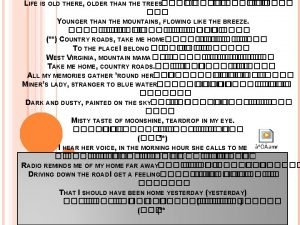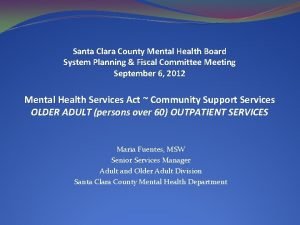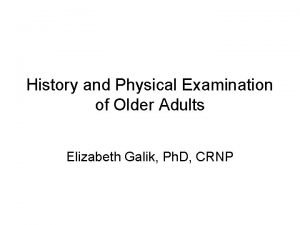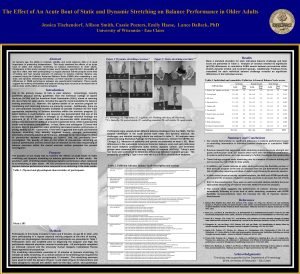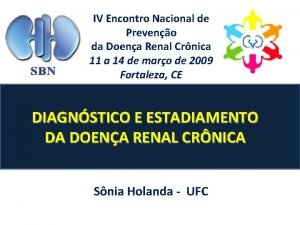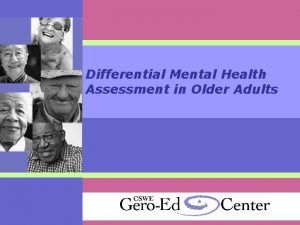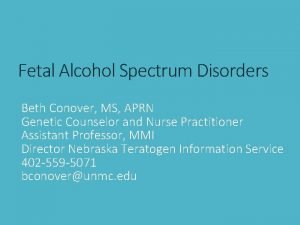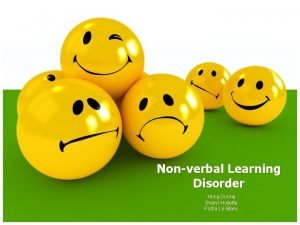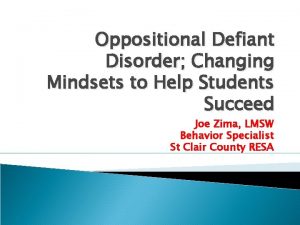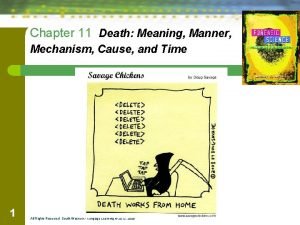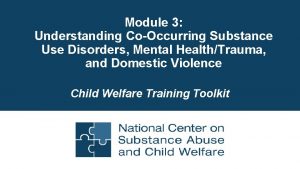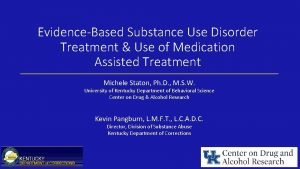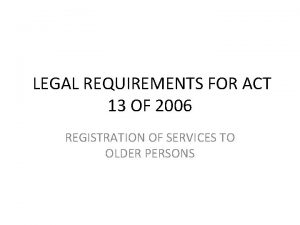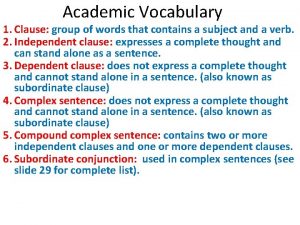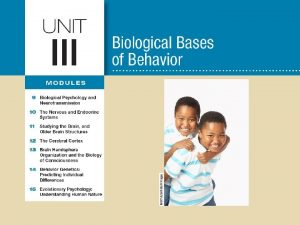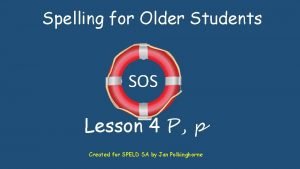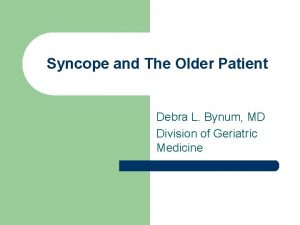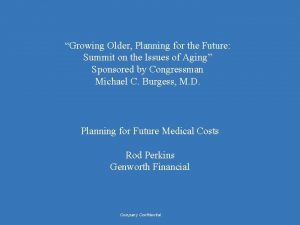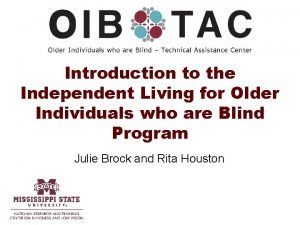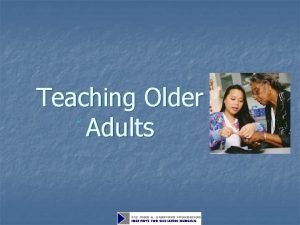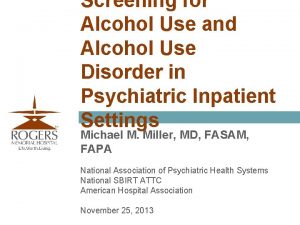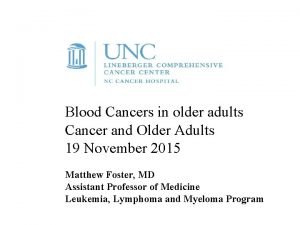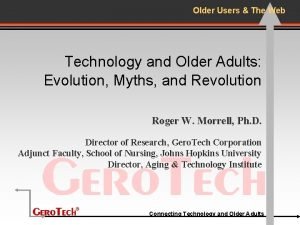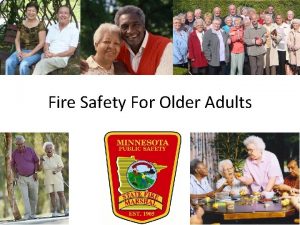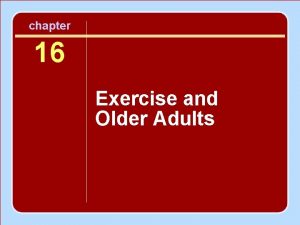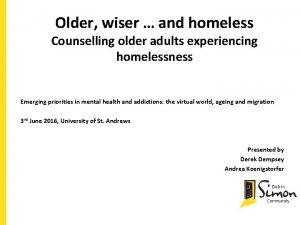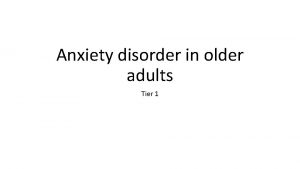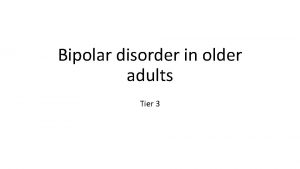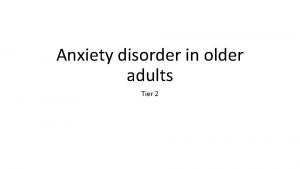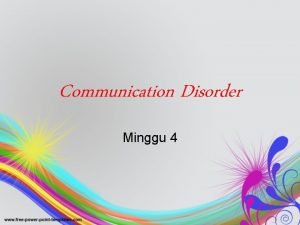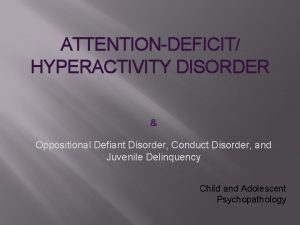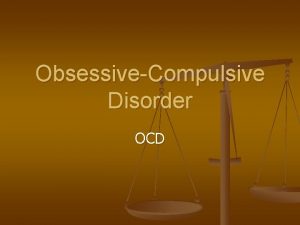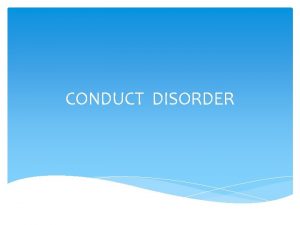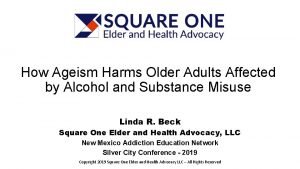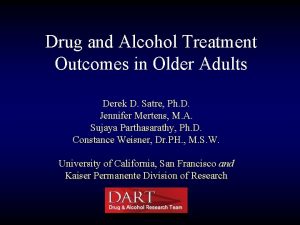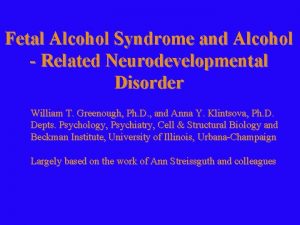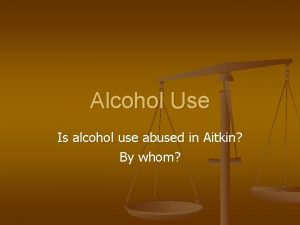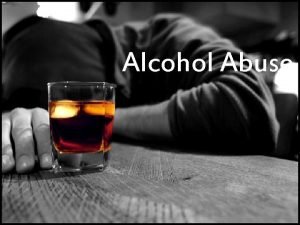Alcohol Use Disorder in Older Adults 12242021 1








































- Slides: 40

Alcohol Use Disorder in Older Adults 12/24/2021 1

Acknowledgements These slides were designed by Dr. David Flores as part of his faculty role in the HRSA sponsored Houston Geriatric Education Center. Please credit Dr. David Flores when utilizing these slides. In addition, Dr. Flores recognized the following persons: • Larry Schonfeld Ph. D, Interim Executive Director, Florida Mental Health Institute Professor, Department of Mental Health Law and Policy • Tiffany Lorton Ph. D, University of Arkansas for the Medical Sciences 2

Funded By This project was funded by a grant from the Health Resources and Services Administration (HRSA) of the Department of Health and Human Services. The grant was initially funded in 2007 with renewed funding for five years beginning in 2010. The grant successfully ended in June, 2015. (Grant #UB 4 HP 19058).

Learning Objectives § Understand current trends of alcohol use disorder in older adults § Identify methods of assessing for alcohol use disorder in older adults § Identify symptoms of alcohol use disorder and withdrawal in older adults § Identify interventions for older adults diagnosed with alcohol use disorder 4

DSM 5 Definition of Alcohol Use Disorder “Clinically significant impairment or distress due to maladaptive patterns of substance use that often results increased tolerance, increased time spent on substance use activities, withdrawals, craving, increased amounts of the substance, unsuccessful efforts to control use, continued usage despite adverse consequences, and a decrease in social, occupational, or recreational activities. ” 5

A Growing Population • Alcohol Use Disorder (AUD) among older adults is rising and will overwhelm national resources (Institute of Medicine, 2012). • Individuals 65 > are projected to increase by 79% from 40. 3 million in 2010 to 72. 1 million by 2030. • Double to 88. 5 million by 2050 (U. S. Census Bureau, 2010). • Individuals 85 and older are projected to triple from 5. 4 million to 19 million by 2050 (Kalapatapu & Sullivan, 2010). 6

Significance of the Problem • Increased need for substance use treatment among older adults. • The “Baby boomer” influence • One in five older adults have a mental health or substance abuse condition. • Lack of healthcare institutions and professionals to meet the needs of older adults. • Older adults with substance abuse disorders (4. 8 million) are projected to double by 2020 • Older adults in need of treatment will escalate to almost 6 million. (Institute of Medicine, 2012; Wang & Andrade, 2013; Gfroerer, 2003). 7

Problems for Law Enforcement • United States, nearly 80, 000 people die from alcohol-related causes, 7 making it the third leading preventable cause of death in our country. 8 • 40% of all traffic related situations involve alcohol • 13% of all the sick days accounted for from work are related to alcohol. • 40% of all aggressive acts involve alcohol in one way or another • 22% of all police time is an alcohol related incident. • There is 1 injury every minute and 1 death every 32 minutes. • Drunk driving accounts for 50 billion dollars per year. • Raising the tax helped reducing alcoholism by 2 -4 times 12/24/2021 Source: http: //pubs. niaaa. nih. gov/publications/Alcohol. Facts&Stats. htm http: //humanbiologylab. pbworks. com/w/page/70380985/Alcoholism 8

So Who is Doing the Drinking? National Survey on Drug Use and Health (Blazer & Wu, 2009) • At risk alcohol misuse and binge drinking among 50 to 64 yrs. compared 65 >. • At risk drinking among 65 >, 13% men and 8% women were at risk drinkers • Of those 65 >, 14% of men and 3% of women were binge drinkers. • Binge drinking among males was associated with higher income, being separated, divorced, or widowed, and being employed. • Binge drinking among women was associated with nonmedical use of prescription drugs. • Use of tobacco and illicit drugs was also associated with binge drinking for both men and women 9

EARLY VS. LATE ONSET DRINKERS • Early onset drinkers have longstanding alcoholrelated problems that generally begin before age 40. and comprise the majority of older patients receiving treatment for alcoholism. • Late onset drinkers appear psychologically and physically healthier. They may begin or increase drinking in response to recent losses such as death of a spouse, isolation, change in health status or retirement. Numbering about one-third of older adults with drinking problems, late onset alcoholism is often milder and more amenable to treatment. 12/24/2021 10

U. S. Substance Abuse Treatment Admissions in 2006 Trunzo & Henderson (Gerontological Society of America presentation 2008) NALL ADMISSIONS = 1, 798, 000 NADMISSIONS OVER 50 = 189, 000 35 -44 yrs 27% 45 -49 yrs 11% 50 -54 yrs: 6% 50+ yrs 11% 25 -34 yrs 25% 18 -24 yrs 18% <18 yrs 8% 55 -59 yrs: 3% 60 -64 yrs: 1% 65+ yrs: <1% Slide courtesy of Larry Schonfeld, Ph. D University of South Florida

Admissions Age 50+ by Alcohol and Drug Use 1992 -2006 Drugs* Alcohol only * Includes primary alcohol use with secondary drug use Slide courtesy of Larry Schonfeld, Ph. D University of South Florida

Admissions Under 50 and Age 50+ by Primary Substance * Excludes methadone Slide courtesy of Larry Schonfeld, Ph. D University of South Florida

Alcohol Use Disorder -Alcohol abuse is prevalent in 10% to 15% of older adults (depending on source) -Symptoms and risks may include: § § § Erratic changes in affect, mood, behavior. Malnutrition Bladder/bowel incontinence Gait disturbances Reoccurring falls/injuries Slide courtesy of Tiffany Lorton Ph. D, UAMS 14

Alcohol Use Disorder Approximately 1/3 of older adults begin to abuse alcohol because of: • Bereavement • Retirement • Loneliness • Physical/emotional illness What is the common theme? : Slide courtesy of Tiffany Lorton Ph. D, UAMS 15

Alcohol Use Disorder Other symptoms of alcohol use disorder: • • • Anxiety Nervousness Blackouts Confusion Weight loss Falls Slide courtesy of Tiffany Lorton Ph. D, UAMS 16

Alcohol Use Disorder Physical assessment of intoxication may reveal: § Alcohol on breath § Unsteady gait § Nystagmus § Positional alcohol nystagmus (PAN) § Nystagmus (visible jerkiness in eye movement) § Impairment in attention or memory What else? Slide courtesy of Tiffany Lorton Ph. D, UAMS 17

Alcohol Use Disorder Prolonged abuse: • Jaundice – alcohol-induced liver disease. • Ascites – Accumulation of fluid in the abdominal cavity usually associated with some liver disease or cirrhosis • Poor personal hygiene • Poor nutritional status Slide courtesy of Tiffany Lorton Ph. D, UAMS 18

Risk Factors • Physical and Medical Risk factors – – – dementia poor physical conditions psychiatric conditions co-morbid health conditions depression. • Psychosocial risk factors – – isolation, retirement economic status the death of family and/or friends. • Older individuals are less likely to seek psychiatric treatment compared with younger individuals (Institute of Medicine, 2012). 19

Risk Factors • The lack of availability of geriatric services and specialists • Alcohol dependent older adults often have co-morbid health/mental health conditions. • Due to the polypharmacy aspects associated with aging, older adults are at greater risk of adverse reactions when using alcohol. 20

HEALTH CONSEQUENCES OF ALCOHOL USE IN OLDER ADULTS 12/24/2021 21

Older Adults, Alcohol Use, and Medications • Many prescriptions, over-the-counter medicines, and herbal remedies can be dangerous or even deadly when mixed with alcohol. • Taking aspirin and drinking alcohol can raise the chance of bleeding in your stomach. • You can get very sleepy if you drink alcohol and take cold or allergy medicines. • Some cough syrups have a high amount of alcohol in them. • Drinking alcohol while taking some sleeping pills, pain pills, or anxiety or depression medicine can be very dangerous. • You can hurt your liver if you drink and take a lot of painkillers that have the word “acetaminophen” on the label. Always check the warning labels. Source: http: //pubs. niaaa. nih. gov/publications/older. Adults. htm 12/24/2021 22

Alcohol Effects the Elderly Different • Induced impairment increases with age due to: – Higher body fat content, less lean muscle mass, and reduced water volume (alcohol is water soluble) – Decreased absorption rate in gastrointestinal system due to decreased blood flow • Affects alcohol’s distribution within the body • Affects alcohol’s elimination • Results in increased sensitivity and decreased tolerance to alcohol and drugs in older individuals • Drugs and alcohol remain in the body longer and at higher rates of concentration 12/24/2021 Slide courtesy of Larry Schonfeld, Ph. D University of South Florida 23

Health Problems Associated with Long-Term Heavy Drinking Cardiovascular disease - Hypertension, heart disease, stroke Cancer (esophagus, mouth, throat, voice box, colon & rectal) Pancreatitis Cognitive impairment (22% - 29% of people with dementia were once heavy drinkers or alcoholics) – Some is reversible with abstinence (acute phases) – Some is not reversible – Wernicke-Korsakoff Syndrome • Liver disease – Steatosis (fatty liver) –can be reversed with abstinence – Alcoholic Hepatitis – Inflammation, necrosis in a small %, may be reversed with abstinence – Cirrhosis – 10%-20%, not reversible • • 12/24/2021 Slide courtesy of Larry Schonfeld, Ph. D University of South Florida 24

More than 2 million Americans suffer from alcohol-related liver disease. “Fatty Liver” - earliest stage and most common alcohol–induced liver disorder. Excessive buildup of triglycerides in liver cells. Can be reversed when drinking stops. Cirrhosis - 10% -20% of heavy drinkers. Scarring, of the liver. Can cause death if drinking continues. Irreversible, but if drinking stops, one's chances of survival improve considerably. Hepatitis – Inflammation and necrosis due to long-term heavy drinking. Symptoms: Fever, jaundice and abdominal pain. Can cause death if drinking continue. May be reversible if drinking stops. Slide courtesy of Larry Schonfeld, Ph. D University of South Florida

Alcohol’s Impact on Organ Systems 12/24/2021 26

Assessing at-risk Drinking or Alcohol Use Disorders • 7 drinks per week or more than 3 drinks daily is considered “risky drinking” for individuals over 65 and women should drink less than men (National Institute on Aging, 2013; National Institute on Alcohol Abuse and Alcoholism, 2005). • Alcohol use is considered contraindicated for older adults who have health conditions or are on medication. (Merrick et al. , 2008) • Ask the patient how much and how often the daily maximum number of drinks has been exceeded. 27

Assessment of Alcohol Misuse Screening tools • The 10 item Alcohol Use Disorders Identification Test (AUDIT) – Useful method for assessing alcohol consumption behaviors and for educating patients on standard sizes of drinks— 12 oz of beer, 5 oz of wine, and 1. 5 oz of 80 proof liquor. • Alcohol Assessment Questions for the Healthcare Practitioner from the Clinical Guidelines of Alcohol Use Disorders – What to ask first. – "Tell me about your use of alcohol, including any beer, wine, or liquor/spirits. ” – Follow up those who have had any alcohol in the last year, by asking – "On average, how many days per week do you drink alcohol? " – "On a typical day when you drink, how many drinks do you have? " – (I drink = 72 ounces of beer, 5 ounces of wine, or 7. 5 ounces of liquor/spirits) – What is the maximum number of drinks you had on any given occasion during the last month? 28

Assessment of Alcohol Misuse Screening Tools The CAGE Questions – – “Have you ever felt that you should Cut down on your drinking? ” “Have people ever Annoyed you by criticizing your drinking? ” “Have you ever felt Guilty about your drinking? ” “Have you ever had a drink (Eye opener) first thing in the morning to steady your nerves or get rid of a hangover? ” • Modified form of The Michigan Alcoholism Screening Test for geriatric population (MASTG) http: //ucsfagrc. org/module_four/pdfs/MAST_G. pdf – More reliable and valid in older population than other instruments 29

The University of South Florida College of Behavioral and Community Sciences SCREENING, BRIEF INTERVENTION AND REFERRAL TO TREATMENT PROJECT (SBRIT) 12/24/2021 30

Slide courtesy of Larry Schonfeld, Ph. D University of South Florida

SBIRT Core Components Slide courtesy of Larry Schonfeld, Ph. D University of South Florida

SBIRT Approach • Universal prescreening (7 items: alcohol, drugs, medications, depressive symptoms) • Full screen (ASSIST) for those with positive prescreens • Level of risk dictates type of service: – – Screening & Feedback (SF) for negative screens Brief Intervention (BI) for moderate risk Brief Treatment (BT) for moderate to high risk Referral to Treatment (RT) - high risk/problem use Slide courtesy of Larry Schonfeld, Ph. D University of South Florida 33

Prescreen – Part 1 Slide courtesy of Larry Schonfeld, Ph. D University of South Florida

Prescreen – Part 2 Slide courtesy of Larry Schonfeld, Ph. D University of South Florida

Alcohol, Smoking and Substance Involvement Screening Test (ASSIST) World Health Organization (WHO) • An interview style screen administered only if there is a positive prescreen • The ASSIST was developed to help healthcare professionals detect and manage substance use • Scores provide a “level of risk” for alcohol or for other substances and type of service that follows: – Low risk = screening & feedback (SF) about results – Moderate risk = indicates the need for brief intervention (BI) using motivational interviewing – Moderate to High Risk = Brief treatment (BT) – High Risk = Referral to treatment Slide courtesy of Larry Schonfeld, Ph. D University of South Florida

INTERVENTIONS FOR OLDER ADULTS MISUSING ALCOHOL 12/24/2021 37

Successful Interventions If alcohol use disorder is suspected, consequences should clearly be communicated with regard to continued alcohol use, recommendations for treatment, facts, symptoms (Willenbring et al. , 2009). 38

Other Successful Interventions Motivational interviewing Substance use counseling Cognitive behavioral Therapy Pharmacotherapy: Naltrexone (Revia), long-acting injectable naltrexone (Vivitrol), acamprosate (Campral), and topiramate (Topamax) – A combination of pharmacotherapy and psychotherapy – Alcohol rehabilitation treatment – – 39

Thank you! 40
 Life is older older than the trees
Life is older older than the trees Older adults mental health
Older adults mental health Shingles older adults
Shingles older adults Dynamic stretching for older adults
Dynamic stretching for older adults Mental health and older adults
Mental health and older adults Older adults
Older adults Mental health and older adults
Mental health and older adults Covids older adults
Covids older adults Altered cognition in older adults is commonly attributed to
Altered cognition in older adults is commonly attributed to Fetal alcohol syndrome face
Fetal alcohol syndrome face Nvld symptoms
Nvld symptoms Idea definition of emotional disturbance
Idea definition of emotional disturbance Odd diagnostic criteria
Odd diagnostic criteria Secondary alcohol oxidation
Secondary alcohol oxidation Primary alcohol vs secondary alcohol
Primary alcohol vs secondary alcohol Fetal alcohol spectrum disorder
Fetal alcohol spectrum disorder Malingering
Malingering Substance use disorder
Substance use disorder Treatment of substance use disorder
Treatment of substance use disorder Hoa/receive/letter/her friend nien/today
Hoa/receive/letter/her friend nien/today As people grow older
As people grow older Web accessibility for older users
Web accessibility for older users Sos spelling for older students
Sos spelling for older students Ajayan is ten years older than vijayan
Ajayan is ten years older than vijayan Older persons act norms and standards
Older persons act norms and standards Breadwinner book characters
Breadwinner book characters Moses older sister
Moses older sister Downsizing and divesting older business
Downsizing and divesting older business Juan continued playing although he injured his knee
Juan continued playing although he injured his knee Shorter and older taller and younger
Shorter and older taller and younger Collective noun of sisters
Collective noun of sisters Module 11 studying the brain and older brain structures
Module 11 studying the brain and older brain structures Intellectual development in older adulthood
Intellectual development in older adulthood Superlativo de helado
Superlativo de helado Sos spelling for older students
Sos spelling for older students Prodigal son elder brother
Prodigal son elder brother Syncope in the older patient is
Syncope in the older patient is Patricia polacco family tree
Patricia polacco family tree The wild swans at coole questions and answers
The wild swans at coole questions and answers Future medical
Future medical Older individuals who are blind program
Older individuals who are blind program
